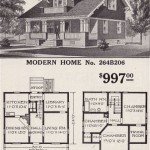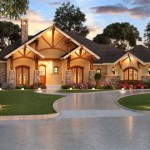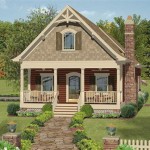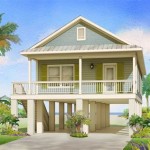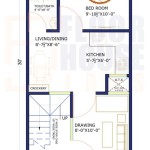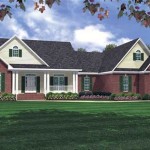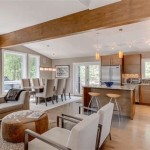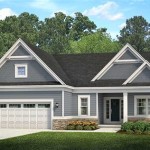Craftsman Style Bungalow Home Plans: A Comprehensive Guide
Craftsman style bungalow home plans represent a significant architectural movement originating in the late 19th and early 20th centuries. Characterized by simplicity, handcrafted details, and a connection to nature, these homes continue to appeal to homeowners seeking a blend of aesthetic beauty and functional design. Understanding the characteristics, benefits, and considerations involved in selecting and implementing Craftsman bungalow home plans is crucial for a successful project.
Key Characteristics of Craftsman Bungalow Architecture
The Craftsman style emerged as a reaction against the ornate and mass-produced aesthetic of the Victorian era. It sought to emphasize honest materials, functional spaces, and the craftsmanship involved in building a home. Key features distinguish these homes from other architectural styles, making them recognizable and desirable:
Low-Pitched Roofs with Wide Eaves: One of the most defining elements, low-pitched gable roofs with deep, overhanging eaves provide substantial protection from the elements. These eaves often feature exposed rafters or decorative brackets, further enhancing the handcrafted aesthetic.
Prominent Front Porches: Large, welcoming front porches are integral to the Craftsman bungalow design. These porches are typically supported by substantial square or tapered columns, often resting on stone or brick piers. The porch serves as an extension of the living space, fostering a sense of community and connection to the outdoors.
Natural Materials: Craftsman homes emphasize the use of natural materials such as wood, stone, and brick. Wood siding is common, often in the form of clapboard, shingles, or board-and-batten. Interior details often incorporate exposed wood beams, trim, and built-in cabinetry.
Open Floor Plans: While early bungalows might have featured more distinct rooms, modern Craftsman bungalows often incorporate open floor plans that promote a sense of spaciousness and connection between living areas. This is achieved by minimizing walls between the living room, dining room, and kitchen.
Abundant Windows: Natural light is a key element in Craftsman bungalows. Large windows, often arranged in groups or featuring multi-pane designs, are common. Double-hung windows and casement windows are frequently used, and stained glass accents can add a touch of artistic flair.
Built-in Features: Built-in cabinetry, shelving, and seating are hallmarks of Craftsman design. These features maximize space utilization and contribute to the handcrafted feel of the home. Common examples include built-in bookcases flanking a fireplace, window seats, and dining room hutches.
Fireplaces: The fireplace often serves as the focal point of the living room in a Craftsman bungalow. Fireplaces are typically constructed of brick or stone and may feature a raised hearth and a decorative mantel. The fireplace provides warmth and a sense of cozy gathering space.
Attention to Detail: Small details contribute significantly to the overall aesthetic of a Craftsman bungalow. These details include exposed rafter tails, decorative brackets, handcrafted light fixtures, and unique hardware. These subtle touches enhance the sense of quality and craftsmanship.
Benefits of Choosing Craftsman Bungalow Home Plans
Selecting Craftsman bungalow home plans offers numerous advantages for homeowners. Beyond the aesthetic appeal, these homes provide practical benefits and a lifestyle that resonates with many individuals and families.
Timeless Appeal: The Craftsman style has proven to be enduringly popular. Its emphasis on simplicity, natural materials, and functional design ensures that these homes retain their appeal over time. This timelessness can contribute to the long-term value of the property.
Connection to Nature: The emphasis on natural materials and the incorporation of outdoor living spaces, such as front porches, create a strong connection to nature. Large windows bring natural light and views of the outdoors into the home, fostering a sense of well-being and tranquility.
Functional Layouts: Craftsman bungalows are typically designed with functional layouts that prioritize comfortable living. Open floor plans promote interaction between family members, while built-in features maximize space utilization and organization. The emphasis is on creating a home that is both beautiful and practical.
Energy Efficiency: While older Craftsman bungalows may require upgrades to meet modern energy efficiency standards, newer plans often incorporate sustainable design principles. Features such as energy-efficient windows, insulation, and heating and cooling systems can help to reduce energy consumption and lower utility bills.
Customization Options: Craftsman bungalow home plans offer a high degree of customization. Homeowners can choose from a wide range of options for materials, finishes, and layouts to create a home that reflects their personal style and meets their specific needs. The inherent flexibility of the design allows for modifications and additions to be incorporated seamlessly.
Strong Resale Value: The enduring popularity of the Craftsman style typically translates into strong resale value. These homes are highly sought after by buyers who appreciate the quality craftsmanship, timeless design, and connection to nature that they offer. Investing in a Craftsman bungalow can be a sound financial decision.
Sense of Community: The welcoming front porch encourages interaction with neighbors and fosters a sense of community. The design promotes a slower pace of life and a connection to the surrounding environment, making it an ideal choice for those seeking a more relaxed and neighborly lifestyle.
Considerations When Implementing Craftsman Bungalow Home Plans
While Craftsman bungalow home plans offer numerous benefits, it is essential to consider several factors to ensure a successful project. Careful planning, budgeting, and attention to detail are crucial for achieving the desired results.
Budget: Building or renovating a Craftsman bungalow can be a significant investment. The use of natural materials and handcrafted details can increase construction costs. It is essential to develop a detailed budget that accounts for all expenses, including materials, labor, permits, and landscaping. Obtaining multiple quotes from contractors and suppliers is crucial for ensuring competitive pricing.
Site Considerations: The topography and orientation of the building site can significantly impact the design and functionality of a Craftsman bungalow. Factors such as sun exposure, drainage, and access to utilities should be carefully considered. A site analysis can help to identify potential challenges and inform the design process.
Local Building Codes and Regulations: Compliance with local building codes and regulations is essential. These codes govern aspects such as structural integrity, fire safety, and energy efficiency. Obtaining the necessary permits and approvals from local authorities is crucial for avoiding delays and potential legal issues.
Contractor Selection: Choosing a qualified and experienced contractor is paramount. Look for a contractor with a proven track record of building or renovating Craftsman-style homes. Check references and review previous projects to assess the contractor's quality of work and attention to detail. Effective communication and collaboration with the contractor are essential for a successful project.
Material Selection: The choice of materials will significantly impact the aesthetic and durability of the home. Opt for high-quality, natural materials that are appropriate for the local climate. Consider the long-term maintenance requirements of different materials and choose options that are both beautiful and practical.
Interior Design: The interior design should complement the architectural style of the Craftsman bungalow. Incorporate natural materials, such as wood and stone, and choose furnishings and accessories that reflect the handcrafted aesthetic. Pay attention to details such as lighting fixtures, hardware, and trim to create a cohesive and harmonious interior.
Landscaping: The landscaping should enhance the natural beauty of the home and create a welcoming outdoor space. Consider incorporating native plants, trees, and shrubs that are adapted to the local climate. A well-designed landscape can improve the curb appeal of the home and provide shade and privacy.
Long-Term Maintenance: Craftsman bungalows require regular maintenance to preserve their beauty and functionality. Inspect the roof, siding, and foundation regularly for signs of damage. Clean gutters and downspouts to prevent water damage. Apply sealant or stain to wood surfaces to protect them from the elements. Regular maintenance will help to extend the life of the home and prevent costly repairs.
By carefully considering these factors, homeowners can successfully implement Craftsman bungalow home plans and create a beautiful, functional, and enduring home that reflects their personal style and values. The blend of aesthetic appeal and practical design ensures that these homes remain a popular choice for generations to come.

Bungalow Floor Plans Style Homes Arts And Crafts Bungalows

House Plan 75137 Craftsman Style With 1879 Sq Ft 3 Bed 2 Bath

1922 Craftsman Style Bunglow House Plan No L 114 E W Stillwell Co

Craftsman Style House Plans Sater Design Collection
:max_bytes(150000):strip_icc()/SL-1873_FCP-8cf5801247c34df0b8bd839eeea78d4d.jpg?strip=all)
23 Craftsman House Plans We Can T Get Enough Of

Craftsman Bungalow House Plan Porte Cochere 3 Bed Bath

Craftsman Bungalow House Plans Company

Craftsman Style Home Plans

Classic Curb Appeal Standout Craftsman House Plans Blog Dreamhomesource Com

Pin Page

